Mesoscale Study on Splitting Tensile Damage Characteristics of Concrete Based on X-ray Computed Tomography and Digital Image Correlation Technology
Abstract
:1. Introduction
2. Experimental Program
2.1. Specimens Preparation
2.2. Brazilian Disc Splitting Tensile Test
2.3. DIC Test System
2.4. CT Scanning Test
3. Results and Discussion
3.1. Splitting Tensile Strength Properties
3.2. Failure Modes
3.2.1. Analysis of the Displacement Field and Strain Field Based on DIC Technology
3.2.2. Analysis of Crack Propagation Based on CT Images
3.3. CT Image Segmentation and Three-Dimensional Reconstruction
3.3.1. Analysis of Gray Histogram Characteristics
3.3.2. CT Image Segmentation Method
3.3.3. Mesoscale Research on the Three-Dimensional Characteristics of Concrete Damage
4. Conclusions
- For the splitting tensile tests, the tensile strength of concrete was 11–30% lower than that of mortar under different loading rates. Compared with concrete, the failure displacement of mortar was more sensitive to the loading rates and increased by 16.38% when the loading rate increased from 0.2 mm/min to 2 mm/s.
- The stress field obtained by the DIC test showed that the cracking modes of the mortar and concrete specimens were different. Concrete specimens cracked from the center, and mortar specimens cracked from the edge, which could affect the reliability of the tensile strength calculation of mortar specimens. Macro cracks gradually formed when the tensile strain of mortar and concrete reached 0.0237 and 0.0836, respectively.
- According to the images obtained from the CT test, the failure mode of the concrete and mortar specimens changed from a single main crack to local punching failure at the loading end with the increase in the loading rates and the decrease in the water/cement ratio. For concrete, interface failure and mortar failure were the main failures under low loading rates, whereas aggregate failure became the main failure mode under a loading rate of 2 mm/s.
- According to the three-dimensional reconstruction results, the internal pores of mortar were small and dense. The size and distribution of aggregates affected the morphology of cracks and made the cracks concave. With the decrease in the water/cement ratios and the increase in the loading rates, the crack surfaces became relatively smooth, as the small aggregates were forced to break away from the matrix.
Author Contributions
Funding
Conflicts of Interest
References
- Liu, T.; Qin, S.; Zou, D.; Song, W.; Teng, J. Mesoscopic modeling method of concrete based on statistical analysis of CT images. Constr. Build. Mater. 2018, 192, 429–441. [Google Scholar] [CrossRef]
- Tian, W.; Han, N. Analysis on meso-damage processes in concrete by X-ray computed tomographic scanning techniques based on divisional zones. Measurement 2019, 140, 382–387. [Google Scholar] [CrossRef]
- Ren, W.; Yang, Z.; Sharma, R.; Zhang, C.; Withers, P. Two-dimensional X-ray CT image based meso-scale fracture modelling of concrete. Eng. Fract. Mech. 2015, 133, 24–39. [Google Scholar] [CrossRef]
- Hou, C.; Wang, Z.; Liang, W.; Li, J.; Wang, Z. Determination of fracture parameters in center cracked circular discs of concrete under diametral loading: A numerical analysis and experimental results. Theor. Appl. Fract. Mech. 2016, 85, 355–366. [Google Scholar] [CrossRef]
- Suchorzewski, J.; Tejchman, J.; Nitka, M. Experimental and numerical investigations of concrete behaviour at meso-level during quasi-static splitting tension. Theor. Appl. Fract. Mech. 2018, 96, 720–739. [Google Scholar] [CrossRef]
- Li, D.; Wong, L. The Brazilian disc test for rock mechanics applications: Review and new insights. Rock Mech. Rock Eng. 2013, 46, 269–287. [Google Scholar] [CrossRef]
- Carmona, S.; Aguado, A. New model for the indirect determination of the tensile stress–strain curve of concrete by means of the Brazilian test. Mater. Struct. 2012, 45, 1473–1485. [Google Scholar] [CrossRef]
- Martínez-López, M.; Martínez-Barrera, G.; Nunes, L.; Reis, J.; Da Costa Mattosa, H.S. Mixed mode fracture analysis in a polymer mortar using the Brazilian disk test. Eng. Fract. Mech. 2016, 154, 140–151. [Google Scholar] [CrossRef]
- Hevroni, D.; Kochavi, E.; Kofman, B.; Gruntmana, S.; Sadot, O. Experimental and numerical investigation on the dynamic increase factor of tensile strength in concrete. Int. J. Impact Eng. 2018, 114, 93–104. [Google Scholar] [CrossRef]
- Malvar, L.J.; Ross, C.A. A Review of Strain Rate Effects for Concrete in Tension. ACI Mater. J. 1998, 95, 735–739. [Google Scholar]
- Wu, S.; Zhou, J.; Chen, H. Mechanism and unified model of concrete dynamic tensile strength improvement based on microstructure characteristics. J. Water Conserv. 2010, 41, 419–428. (In Chinese) [Google Scholar] [CrossRef]
- Květoňa, J.; EliáŠa, J. Influence of inertia and material properties on discrete simulation of dynamic fracture of concrete. Procedia Struct. Integr. 2018, 13, 1367–1372. [Google Scholar] [CrossRef]
- Zhou, R.; Chen, H.M.; Lu, Y. Mesoscale modelling of concrete under high strain rate tension with a rate-dependent cohesive interface approach. Int. J. Impact Eng. 2020, 139, 103500. [Google Scholar] [CrossRef]
- Jin, X.; Hou, C.; Fan, X.; Lu, C.; Yang, H.; Shu, X.; Wang, Z. Quasi-static and dynamic experimental studies on the tensile strength and failure pattern of concrete and mortar discs. Sci. Rep. 2017, 7, 15305. [Google Scholar] [CrossRef] [Green Version]
- Zhou, Z.; Zhou, Y.; Li, X.; Jiang, Y. Stress evolution and failure process of Brazilian disc under impact. J. Cent. South Univ. 2013, 20, 172–177. [Google Scholar] [CrossRef]
- Xudong, C.; Limei, G.; Jikai, Z.; Sheng, X.W. Experimental Study on Split Hopkinson Pressure Bar Pulse-Shaping Techniques for Concrete. J. Mater. Civ. Eng. 2016, 28, 04015196. [Google Scholar] [CrossRef]
- Xudong, C.; Limei, G.; Jikai, Z.; Shengxing, W. Dynamic Brazilian Test of Concrete Using Split Hopkinson Pressure Bar. Mater. Struct. 2017, 50, 1. [Google Scholar] [CrossRef]
- Yang, W. Finite element model of concrete material based on CT image processing technology. J. Vis. Commun. Image Represent. 2019, 64, 102631. [Google Scholar] [CrossRef]
- Lang, L.; Zhu, Z.; Zhang, X.; Qiu, H.; Zhou, C. Investigation of crack dynamic parameters and crack arresting technique in concrete under impacts. Constr. Build. Mater. 2019, 199, 321–334. [Google Scholar] [CrossRef]
- Zhu, L.; Dang, F.; Xue, Y.; Ding, W.; Zhang, L. Comparative study on the meso-scale damage evolution of concrete under static and dynamic tensile loading using X-ray computed tomography and digital image analysis. Constr. Build. Mater. 2020, 250, 118848. [Google Scholar] [CrossRef]
- Castellano, A.; Fraddosio, A.; Piccioni, M.; Kundu, T. Linear and Nonlinear Ultrasonic Techniques for Monitoring Stress-Induced Damages in Concrete. J. Nondestruct. Eval. Diagn. Progn. Eng. Syst. 2021, 4, 041001. [Google Scholar] [CrossRef]
- Payan, C.; Garnier, V.; Moysan, J. Potential of Nonlinear Ultrasonic Indicators for Nondestructive Testing of Concrete. Adv. Civ. Eng. 2014, 2010, 238472. [Google Scholar] [CrossRef] [Green Version]
- Antonaci, P.; Bruno, C.L.E.; Gliozzi, A.S.; Scalerandi, M. Monitoring evolution of compressive damage in concrete with linear and nonlinear ultrasonic methods. Cem. Concr. Res. 2010, 40, 1106–1113. [Google Scholar] [CrossRef]
- Shen, J.; Xu, Q.; Liu, M. Statistical analysis of defects within concrete under elevated temperatures based on SEM image. Constr. Build. Mater. 2021, 293, 123503. [Google Scholar] [CrossRef]
- Maruschak, P.O.; Chausov, M.G.; Konovalenko, I.V.; Yasnii, O.P.; Vlasov, I.V. Effect of Shock and Vibration Loading on the Fracture Mechanisms of a VT23 Titanium Alloy. Strength Mater. 2020, 52, 252–261. [Google Scholar] [CrossRef]
- Wang, X.; Jin, Z.; Liu, J.; Chen, F.; Feng, P.; Tang, J. Research on internal monitoring of reinforced concrete under accelerated corrosion, using X-CT and DIC technology. Constr. Build. Mater. 2021, 266, 121018. [Google Scholar] [CrossRef]
- Li, D.; Huang, P.; Chen, Z.; Yao, G.; Guo, X.; Zheng, X.; Yang, Y. Experimental study on fracture and fatigue crack propagation processes in concrete based on DIC technology. Eng. Fract. Mech. 2020, 235, 107166. [Google Scholar] [CrossRef]
- Mamand, H.; Chen, J. Extended digital image correlation method for mapping multiscale damage in concrete. J. Mater. Civ. Eng. 2017, 29, 04017179. [Google Scholar] [CrossRef] [Green Version]
- Lawler, J.; Keane, D.; Shah, S. Measuring three-dimensional damage in concrete under compression. Mater. J. 2001, 98, 465–475. [Google Scholar]
- Kim, J.; Chung, S.; Han, T.; Stephan, D.; Elrahman, M. Correlation between microstructural characteristics from micro-CT of foamed concrete and mechanical behaviors evaluated by experiments and simulations. Cem. Concr. Compos. 2020, 112, 103657. [Google Scholar] [CrossRef]
- Skaryński, L.; Tejchman, J. Investigations on fracture in reinforced concrete beams in 3-point bending using continuous micro-CT scanning. Constr. Build. Mater. 2021, 284, 122796. [Google Scholar] [CrossRef]
- Chung, S.; Kim, J.; Stephan, D.; Han, T. Overview of the use of micro-computed tomography (micro-CT) to investigate the relation between the material characteristics and properties of cement-based materials. Constr. Build. Mater. 2019, 229, 116843. [Google Scholar] [CrossRef]
- Loeffler, C.; Qiu, Y.; Martin, B.; Heard, W.; Williams, B.; Nie, X. Detection and segmentation of mechanical damage in concrete with X-Ray microtomography. Mater. Charact. 2018, 142, 515–522. [Google Scholar] [CrossRef]
- Hao, S.; Dang, F.; Chen, H.; Liang, X. Three dimension reconstruction of concrete meso-structure based on CT images by ANSYS. Concrete 2009, 3, 13–15. (In Chinese) [Google Scholar]
- Jin, L.; Yu, W.; Du, X.; Yang, W. Mesoscopic numerical simulation of dynamic size effect on the splitting-tensile strength of concrete. Eng. Fract. Mech. 2019, 209, 317–332. [Google Scholar] [CrossRef]
- Kadleček, S.; Modrý, S.; Kadleček, J. Size effect of test specimens on tensile splitting strength of concrete: General relation. Mater. Struct. 2002, 35, 28–34. [Google Scholar] [CrossRef]
- Huang, Y. Study on the Size Effect of Concrete Brittleness and Mechanical Parameters and Their Relationship; Chongqing University: Chongqing, China, 2002. [Google Scholar]
- Wang, J.; Xu, L.; Lu, Y. Application of edge detection in industrial CT image. Nondestruct. Test. 2007, 29, 61–65. (In Chinese) [Google Scholar] [CrossRef]
- Skaryński, L.; Kozicki, J.; Tejchman, J. Application of DIC Technique to Concrete—Study on Objectivity of Measured Surface Displacements. Exp. Mech. 2013, 53, 1545–1559. [Google Scholar] [CrossRef]
- Wu, Z.M.; Hua, R.; Zheng, J.J.; Feng, X.; Wei, D. An experimental investigation on the FPZ properties in concrete using digital image correlation technique. Eng. Fract. Mech. 2011, 78, 2978–2990. [Google Scholar] [CrossRef]
- Zheng, K. Study on Mesostructure and Damage Characteristics of Coal Gangue Particles Based on X-ray CT; China University of Mining and Technology: Beijing, China, 2016. [Google Scholar]
- Mao, L.; Sun, Q.; Yuan, Z.; Liu, Y.L.; Hb, L. Crack and strain field analysis in concrete under uniaxial compression based on CT images. J. Build. Mater. 2016, 19, 449–455. (In Chinese) [Google Scholar]
- Hao, J.; Jiang, Y.; Mei, S.; Zhu, L. Identification of crack in concrete interior based on X-ray CT. Concrete 2010, 10, 44–47. [Google Scholar] [CrossRef]
- Maruschak, P.O.; Konovalenko, I.V.; Bishchak, R.T. Effect of thermal fatigue cracks on brittle-ductile deformation and failure of cbcm roller surface layers. Metallurgist 2012, 56, 30–36. [Google Scholar] [CrossRef]

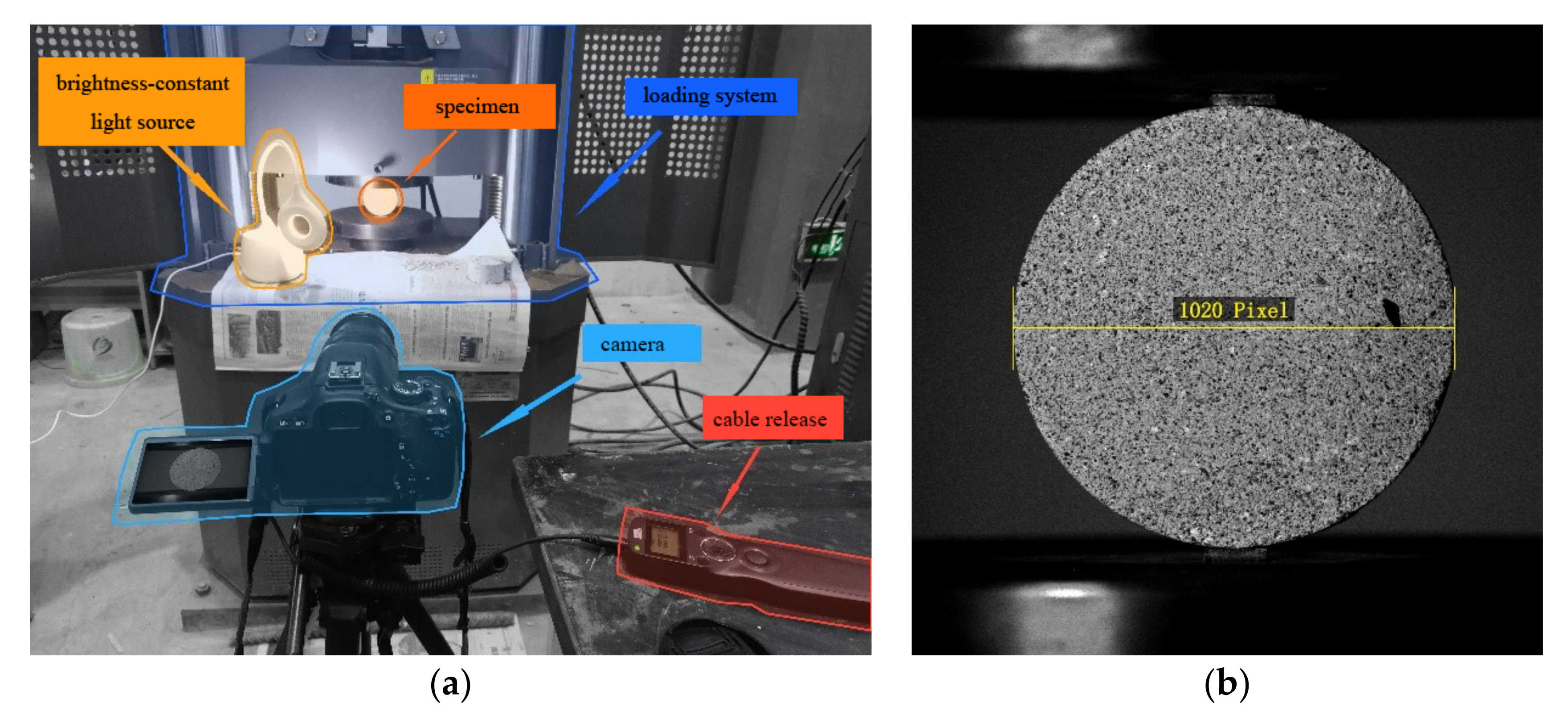

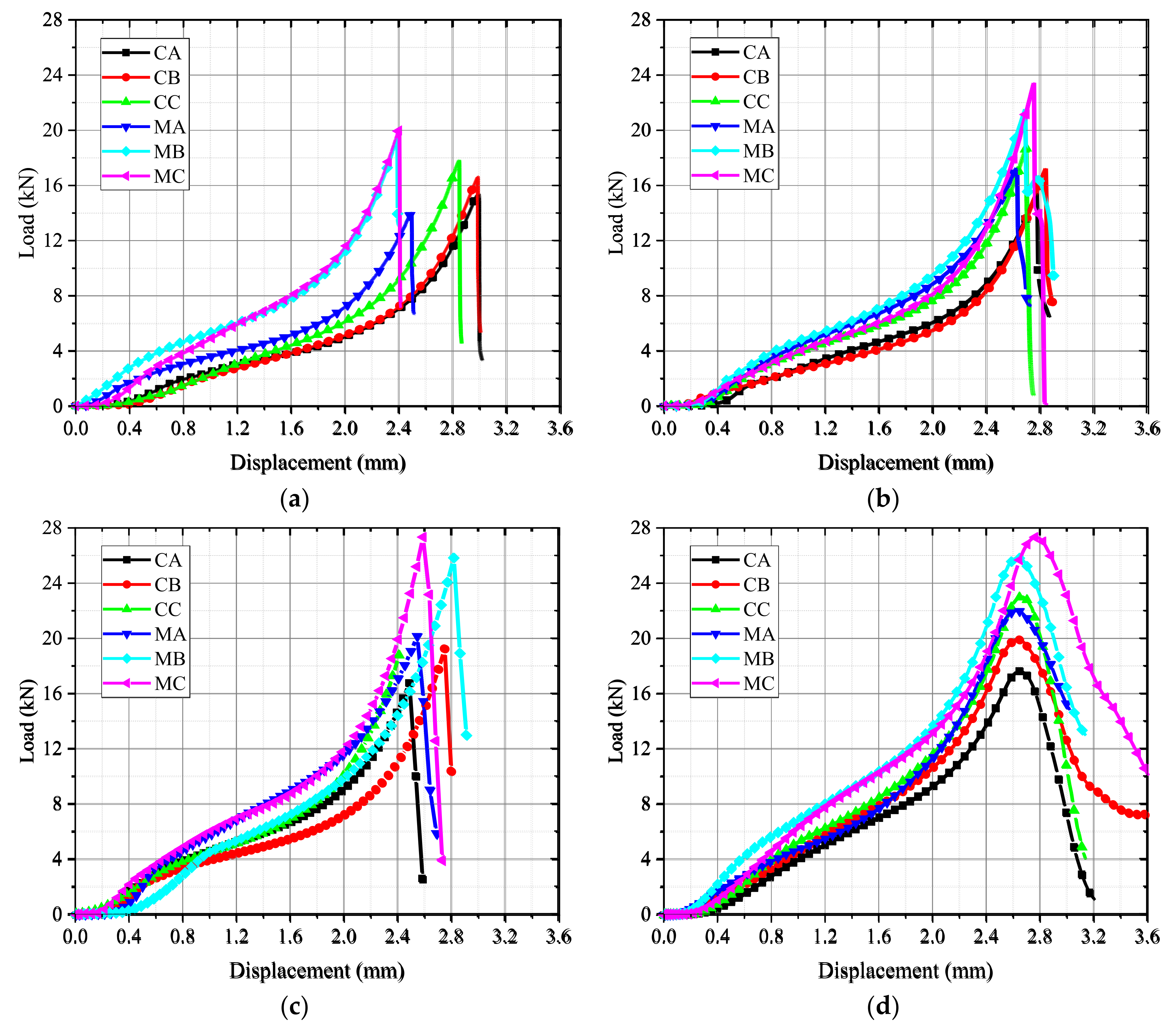
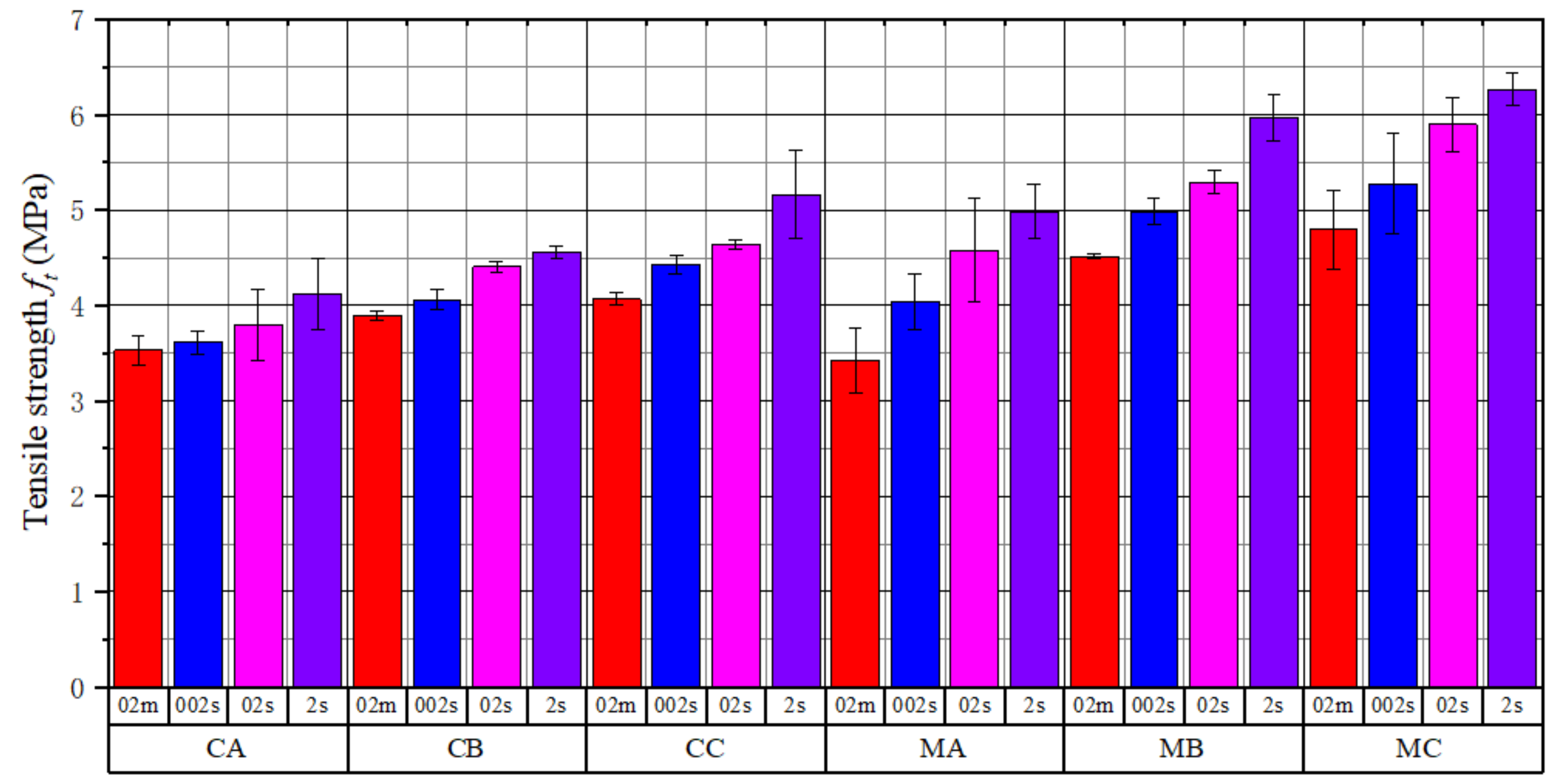
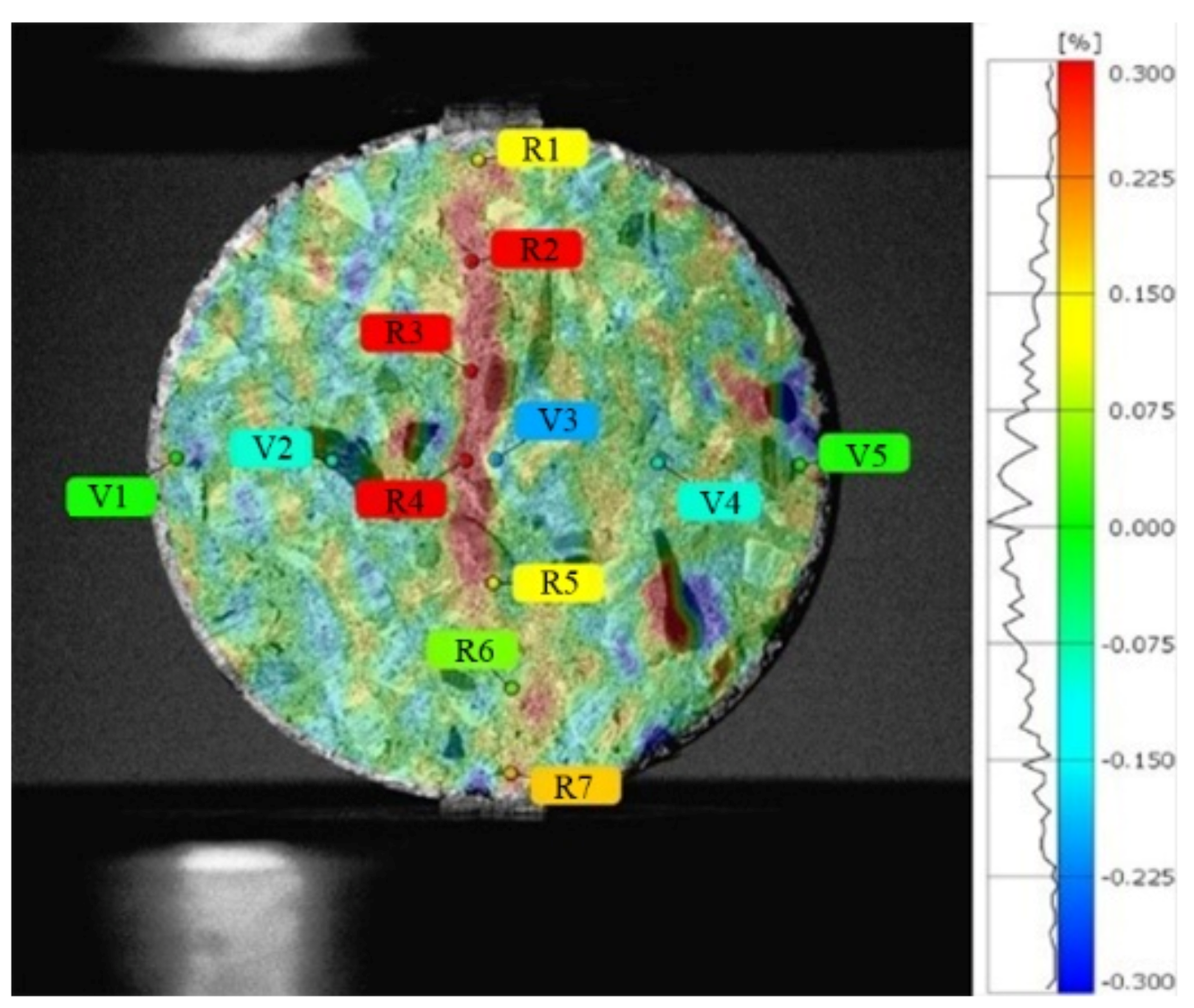

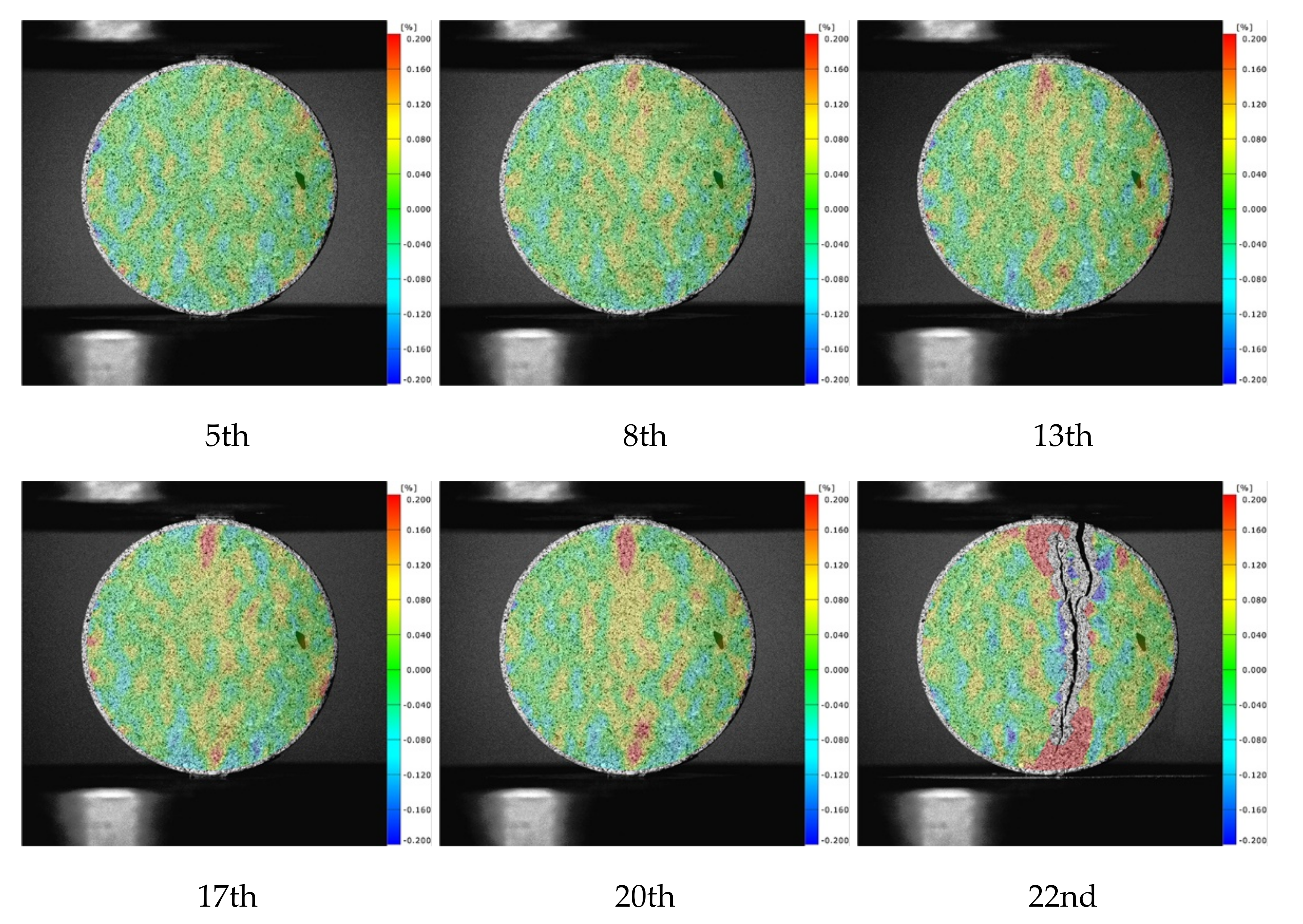





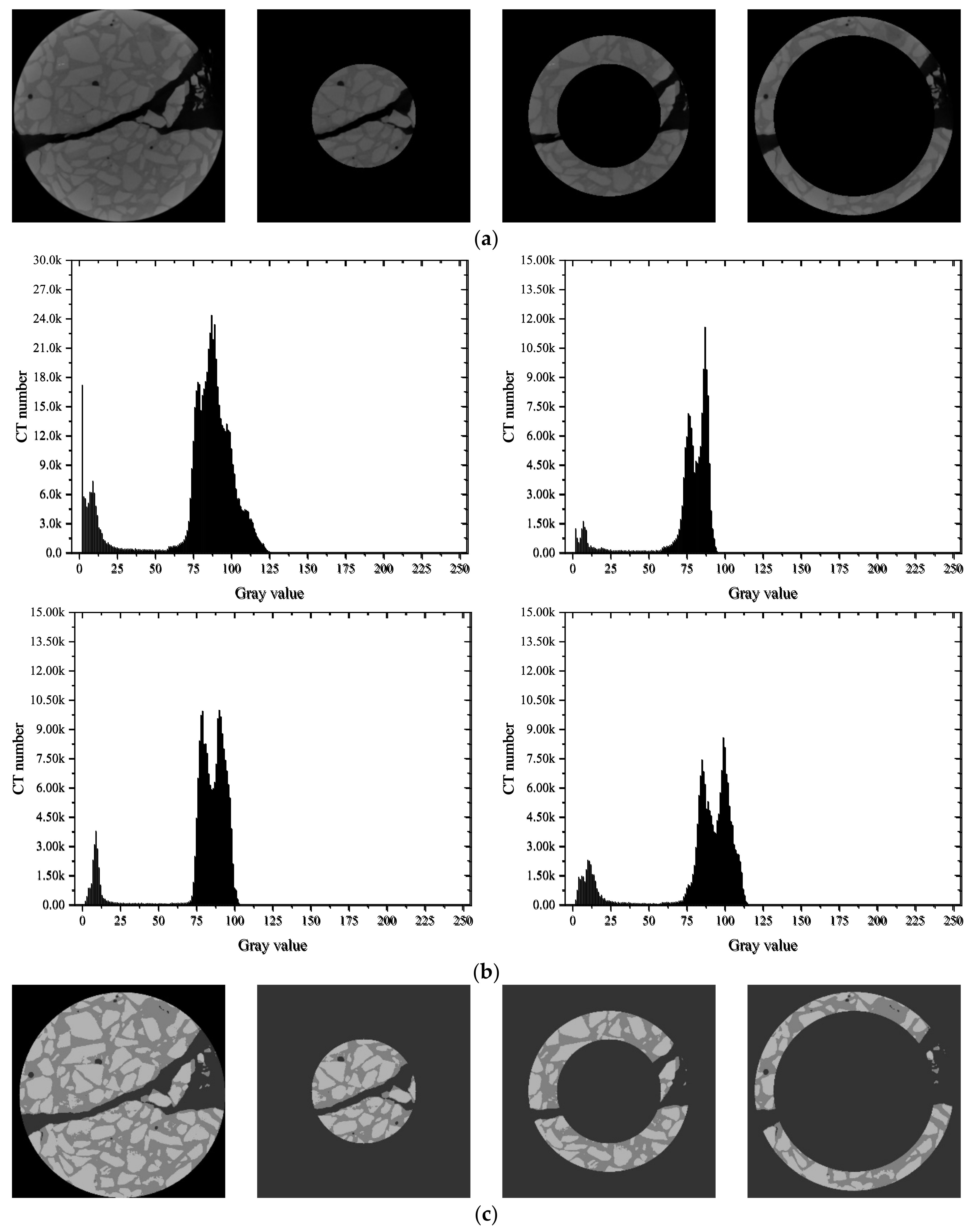
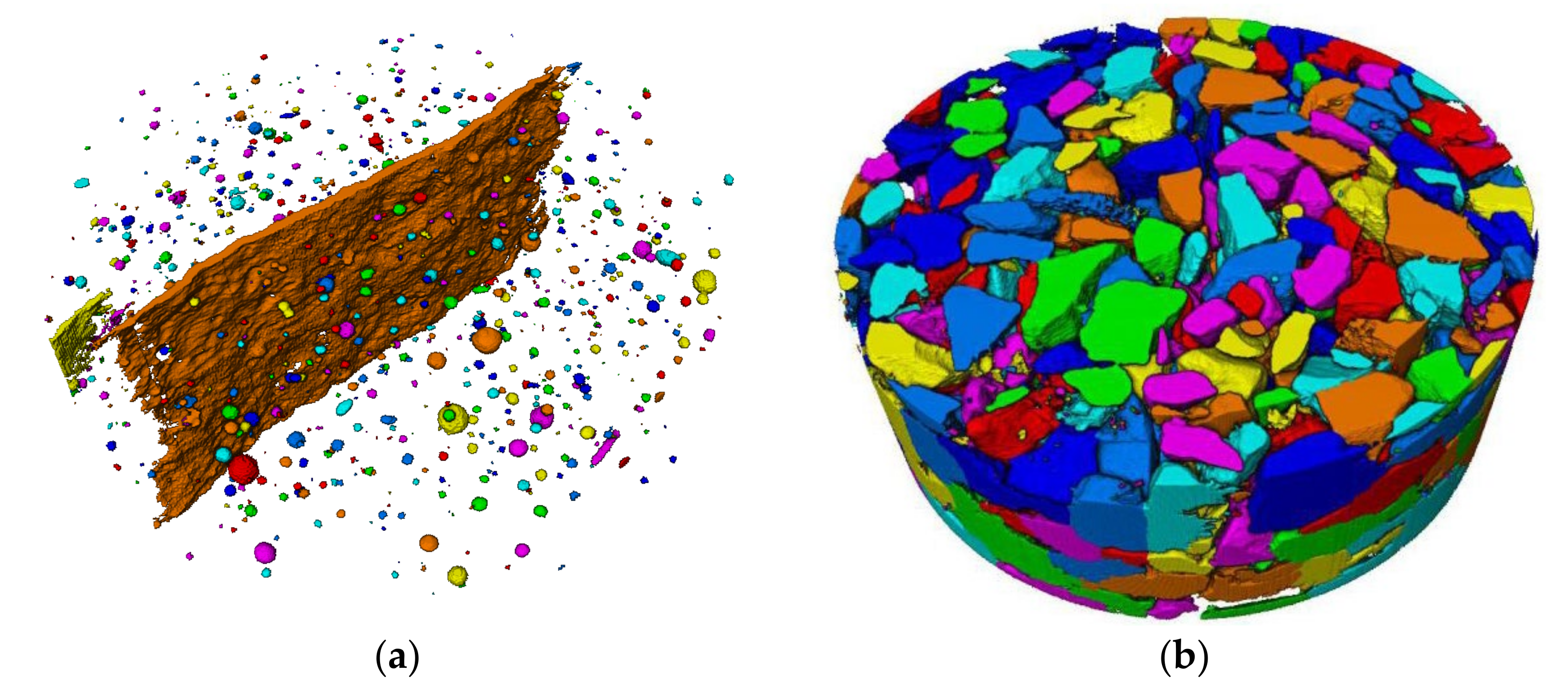
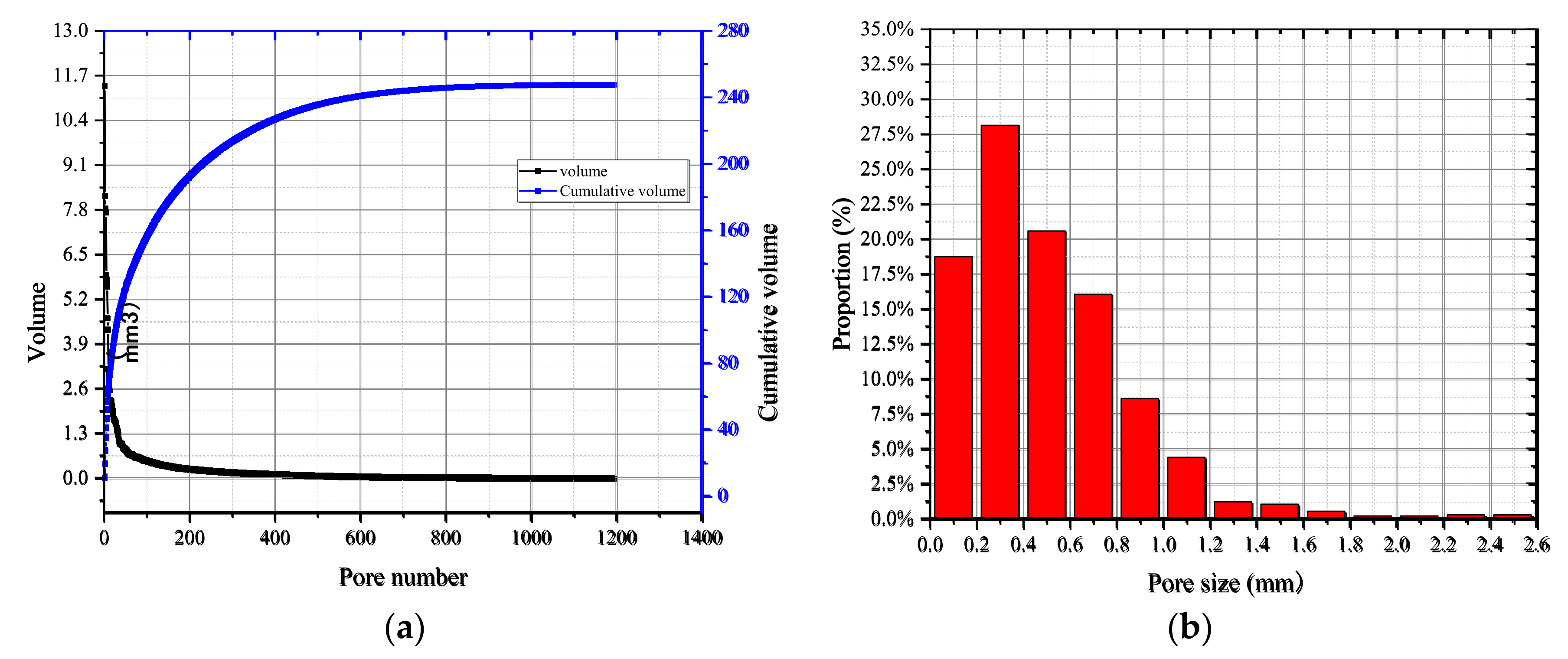


| Materials | Type | Water | Cement | Fine Aggregate | Coarse Aggregate | Design Strength |
|---|---|---|---|---|---|---|
| Concrete | CA | 0.64 | 1.00 | 2.12 | 3.22 | C25 |
| CB | 0.56 | 1.00 | 1.85 | 2.86 | C35 | |
| CC | 0.41 | 1.00 | 1.02 | 2.09 | C45 | |
| Cement mortar | MA | 0.64 | 1.00 | 2.12 | / | / |
| MB | 0.56 | 1.00 | 1.85 | / | / | |
| MC | 0.41 | 1.00 | 1.02 | / | / |
| Type | CA-02 m | CA-2 s | CC-02 m | CC-2 s | MA-02 m | MA-2 s |
|---|---|---|---|---|---|---|
| Pore | 0.05% | 0.14% | 0.07% | 0.37% | 0.24% | 0.25% |
| Crack | 1.36% | 7.69% | 1.51% | 12.17% | 1.18% | 5.57% |
| Mortar | 54.70% | 50.61% | 45.67% | 36.13% | 98.58% | 94.18% |
| Aggregate | 43.89% | 41.56% | 52.75% | 51.33% | - | - |
Publisher’s Note: MDPI stays neutral with regard to jurisdictional claims in published maps and institutional affiliations. |
© 2022 by the authors. Licensee MDPI, Basel, Switzerland. This article is an open access article distributed under the terms and conditions of the Creative Commons Attribution (CC BY) license (https://creativecommons.org/licenses/by/4.0/).
Share and Cite
Zhang, H.; Pan, Q.; Zheng, K.; Jin, C.; Pan, L. Mesoscale Study on Splitting Tensile Damage Characteristics of Concrete Based on X-ray Computed Tomography and Digital Image Correlation Technology. Materials 2022, 15, 4416. https://doi.org/10.3390/ma15134416
Zhang H, Pan Q, Zheng K, Jin C, Pan L. Mesoscale Study on Splitting Tensile Damage Characteristics of Concrete Based on X-ray Computed Tomography and Digital Image Correlation Technology. Materials. 2022; 15(13):4416. https://doi.org/10.3390/ma15134416
Chicago/Turabian StyleZhang, Hua, Qi Pan, Kai Zheng, Chuanjun Jin, and Luoyu Pan. 2022. "Mesoscale Study on Splitting Tensile Damage Characteristics of Concrete Based on X-ray Computed Tomography and Digital Image Correlation Technology" Materials 15, no. 13: 4416. https://doi.org/10.3390/ma15134416
APA StyleZhang, H., Pan, Q., Zheng, K., Jin, C., & Pan, L. (2022). Mesoscale Study on Splitting Tensile Damage Characteristics of Concrete Based on X-ray Computed Tomography and Digital Image Correlation Technology. Materials, 15(13), 4416. https://doi.org/10.3390/ma15134416





